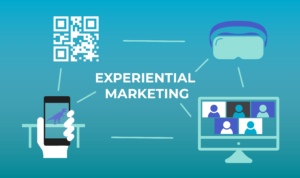
Before the pandemic, brands were dabbling in experiential marketing coming up with creative, innovative ways to interact with their consumers. The pandemic has presented the challenge to offer virtual experiences and socially distanced experiences.
What is experiential marketing? Some refer to it as “live marketing” or “event marketing”. It is creating a live experience for consumers that will leave a memorable impression.
Some notable examples of experiential marketing:
- Gilmore Girls’ created 200 popup diners to mimic Luke’s diner from the show.
- Lush tested their products on consumers right in their store at their testing stations. Equipped with a bowl of hot water, towels, and a customer service rep to give nice hand massages.
- Best Buy and similar stores let customers test out VR technology that was set up on one of their TVs.
- Milka created a campaign that involved producing 10 million bars of chocolate with a single piece missing. Confused customers were then directed to a dedicated microsite and offered a choice: they could either have the piece of chocolate sent back to them or sent to a loved one instead. (Source)
- Non-profits have used experiential marketing to help gain donations. For example, Hope International, a microfinancing organization that works in many impoverished communities has created an exhibit that walks you through what life is like for people in poverty. They also created a Poverty Simulation which is a 2.5-hour immersive experience hosted by a local church.
In 2020, experiential marketing had to be re-invented. Virtual events replaced in-person gatherings which means marketers had to find creative ways to attract attention, put on a show, and distinguish it from all the Zoom meetings people attended at work or school.
For example, some artists started to hold drive-up concerts. Similar to a drive-in movie theater, people and families could drive up, roll down their windows and enjoy the concert from their covid protected vehicles.
Now in 2021, companies are coming up with hybrid experiences. Some involve being in person, with the use of QR codes and augmented reality, to allow for socially distanced interactive experiences. Some involve offering an in-person experience with limitations due to the ongoing pandemic, as well as providing a virtual experience for those that can’t come in person.
Precedents are being set. This past year will be a catalyst for new inventive ways to provide customer experiences. It will be no surprise when existing (and new) social media platforms include advanced VR and AR tools as well as capabilities to host virtual events.
Even when gatherings are once again safe, these virtual experiences will remain. Brands are becoming more adept at experimenting and adapting. This is here to stay.
How is your brand embracing new technologies and innovating your marketing techniques?
Source: https://www.marketingdive.com/news/brands-get-back-together-with-experiential-marketing-in-time-for-valentine/594850/?utm_source=Sailthru&utm_medium=email&utm_campaign=Issue:%202021-02-11%20Marketing%20Dive%20Newsletter%20%5Bissue:32395%5D&utm_term=Marketing%20Dive
